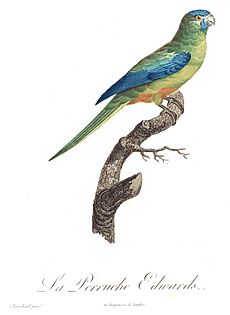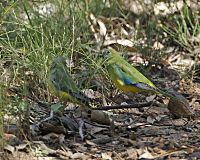Turquoise parrot facts for kids
Quick facts for kids Turquoise parrot |
|
|---|---|
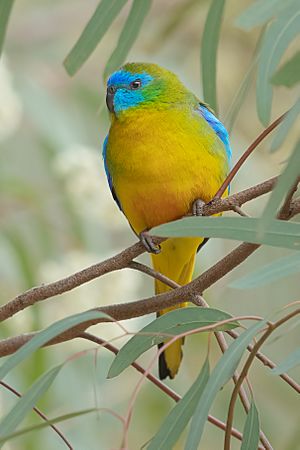 |
|
| male | |
 |
|
| female | |
| Conservation status | |
| Scientific classification | |
| Genus: |
Neophema
|
| Species: |
pulchella
|
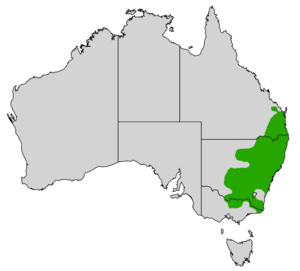 |
|
| Turquoise parrot range | |
| Synonyms | |
|
Psittacus edwardsii Bechstein, 1811 |
|
The turquoise parrot (Neophema pulchella) is a beautiful small parrot found in Eastern Australia. It lives in places like southeastern Queensland, New South Wales, and northeastern Victoria. George Shaw first described this bird in 1792.
This parrot is quite small, about 20 cm (8 in) long and weighing around 40 g. Male and female turquoise parrots look different. The male is mostly green with a bright turquoise-blue face and blue wings with red shoulders. The female is usually duller, with a pale green chest and yellow belly. She does not have the red patch on her wing.
Turquoise parrots live in grasslands and open woodlands with Eucalyptus and Callitris trees. They mostly eat grass and seeds. Sometimes they also eat flowers, fruit, and small insects. They build their nests in hollows inside gum trees. Sadly, many of their homes have been changed or lost. While they usually stay in one place, they can sometimes move around locally. Their numbers are now growing after a big drop in the early 1900s. People have kept turquoise parrots as pets since the 1800s, and there are even different color types.
Contents
Taxonomy and naming
The turquoise parrot was well known around Sydney when Europeans first settled there in 1788. George Shaw officially described it in 1792, calling it Psittacus pulchellus. He named it "Turquoisine" because of its turquoise face.
Later, in 1891, an Italian bird expert named Tommaso Salvadori created a new group of parrots called Neophema. He placed the turquoise parrot in this group, giving it its current scientific name. There are not many differences between turquoise parrots from different areas.
The turquoise parrot is one of six "grass parrots" in the Neophema group. It is most closely related to the scarlet-chested parrot. These two are the only parrots in their group where the male and female look very different.
Over time, this bird has had many English names. Some of these include chestnut-shouldered parakeet and turquoisine grass parrot.
Description
The turquoise parrot is a small, slender bird, about 20 to 22 cm (8–83⁄4 in) long. It has a wingspan of about 32 cm (123⁄4 in) and weighs around 40 g. Both male and female birds have green upper parts and yellow underparts.
The male has a bright turquoise-blue face. This blue is darkest on its head and lighter on its cheeks. Its neck and upper body are grass-green, and its tail is green with yellow edges. When its wing is folded, it looks bright blue with a dark front edge and a red band on the shoulder. Its belly is bright yellow, sometimes with orange patches. The top part of its beak is black, and its eyes are dark brown.
The female is generally duller and paler. Her face is a more even, lighter blue, and she has light cream skin around her eyes. She does not have the red shoulder band. Her throat and chest are pale green, and her belly is yellow. When she flies, you can see a wide white stripe under her wing.
Young birds of both sexes have less blue on their faces, which does not go past their eyes. Their upper bodies look like the adult female's. Both young males and females have a white stripe on their wings. This stripe disappears in males as they grow up. Young males also have a red patch on their wing and might have an orange tint on their belly.
Distribution and habitat
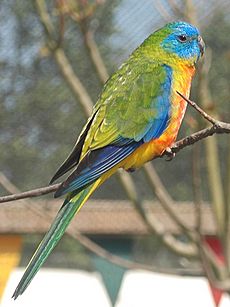
The turquoise parrot lives in the hills of the Great Dividing Range and nearby areas. In Queensland, you can find them as far north as Cooloola and Chinchilla. In New South Wales, they live across the central and eastern parts of the state. In Victoria, they are found near Wangaratta and Mallacoota.
These parrots live in open woodlands and savanna woodlands. These areas often have native cypress trees (Callitris species) or eucalyptus trees. They prefer rocky ridges, gullies, or areas where different habitats meet, like where woodlands meet grasslands.
Turquoise parrots usually stay in one place and do not migrate far. However, their exact movements are not fully known. Some populations might move around locally to find water.
Conservation status
About 90% of all turquoise parrots live in New South Wales. This species is not listed as threatened by the Australian government. However, some experts suggested it was "near threatened" in 2000 because its numbers had dropped a lot.
Its population and range have changed a lot over time. It was common across eastern Australia until the 1880s. Then, it almost disappeared from many areas and was even thought to be extinct in 1915. It was not seen in Queensland between 1923 and 1950, or in Victoria between the 1880s and 1949. However, numbers in New South Wales started to grow in the 1930s. By the 1960s, the species had returned to East Gippsland. In 2000, there were an estimated 20,000 breeding birds, and their population is still thought to be increasing.
New South Wales
The turquoise parrot used to be common around Sydney. But its numbers dropped sharply between 1875 and 1895. This was partly because they were caught for the pet trade and their habitat was destroyed. Almost all of their preferred home, the Cumberland Plain in western Sydney, has been cleared for buildings. More than half of the woodlands in New South Wales have been cleared.
A big problem is the removal of old eucalyptus trees. These trees have hollows that the parrots need for nesting. Because of this, the species is listed as a Vulnerable species in New South Wales. Also, certain fire management plans might cause shrubs to grow instead of grasses, which the parrots prefer to eat. Wild cats and foxes are also a danger, especially to nesting birds and their young.
Victoria
The turquoise parrot was once common in Victoria but was almost extinct by 1917. However, its numbers have grown again since the 1930s and 1940s. It has now returned to its old territories. In Victoria, this species is currently listed as near threatened.
Behaviour
Turquoise parrots are usually seen in pairs or small family groups. Outside the breeding season, they might gather in larger flocks of up to 75 birds, mostly young ones. As the breeding season gets closer, pairs will separate from these larger groups.
In autumn and winter, turquoise parrots sleep together in groups. At night, they roost (rest) among the leaves of trees like gums or wattles. They usually perch 1 to 8 m (3–25 ft) above the ground. During the day, they go to trees near their feeding areas.
The sounds of the turquoise parrot have not been studied much. They make a soft, high-pitched call when they are eating or flying. Their alarm call is a high-pitched "zitting" sound. They also chatter when they settle down to sleep in the evening.
Reproduction
Turquoise parrots stay with one partner for life. When a male wants to attract a female, he sits upright on a tree stump and spreads his wings to show off his red and blue colors. Once they are a pair, both birds look for a nesting spot, but the female makes the final choice.
They breed during the warmer months, laying eggs from August to January. They use vertical or almost vertical hollows in live or dead trees, usually eucalyptus trees. Sometimes, they even use old fence posts. The tree with the hollow is often in open woodland, and the hollow is usually at least 1 m (3 ft) above the ground.
The female lays her eggs on a bed of wood dust or leaves. A clutch (group of eggs) usually has two to five glossy white eggs, but sometimes up to eight. Each egg is about 21 to 22 mm long and 18 mm (0.8 by 0.7 in) wide. Eggs are laid every two to three days.
About 56% of the eggs hatch and the young birds successfully leave the nest. Animals like the lace monitor (a type of lizard) and red fox can be predators of the nests. Baby birds can also get too hot in very hot weather or drown in the hollows after heavy rain.
Feeding
The turquoise parrot mainly eats seeds from the ground. They look for food in open woodlands, forest edges, and near trees in open areas like pastures. Sometimes they eat along roadsides. They usually feed in pairs or small groups of up to thirty or even fifty birds. They prefer to eat in shaded areas, where their green feathers help them blend in with the grass.
Their diet mostly consists of grass and shrub seeds. They also eat leaves, flowers, fruit, and small insects. They have been seen eating seeds from many different plants. Some common foods include the fruit of common fringe-myrtle, seeds and fruit of erect guinea-flower, and seeds from various types of grasses. They also eat seeds from common chickweed and capeweed. Sometimes, they even drink nectar from flowers or eat moss spores.
One female parrot was seen putting leaves of the flaky-barked tea-tree under her feathers. People wondered if she was using the leaves to keep insects away or kill them.
Aviculture
The turquoise parrot was a popular pet bird in the 1800s. However, it was rarely seen in captivity between 1928 and 1956. A big problem was that many of their eggs did not hatch. Since then, they have become more common and have adapted well to living in cages. They are quiet birds and enjoy bathing.
There is a chance they might breed with other parrots from the Neophema group if kept together. Breeders have created turquoise parrots with more orange on their bellies. There is also a yellow version of the parrot, which first appeared in the 1950s. In this form, the blue color is missing, but the yellow and red colors remain. Other color types include red-fronted and pied (both are rare genetic changes), and jade and olive (which are more common genetic changes).
See also
 In Spanish: Periquito turquesa para niños
In Spanish: Periquito turquesa para niños



